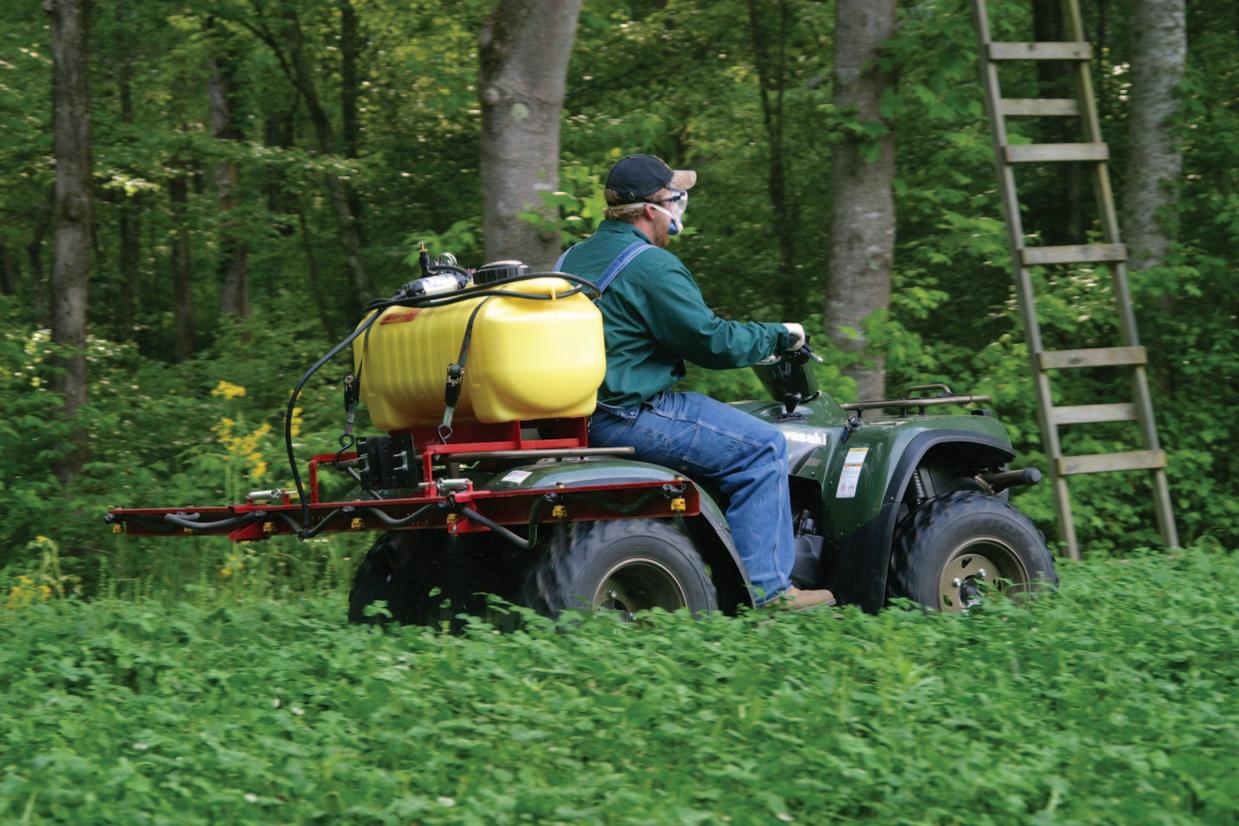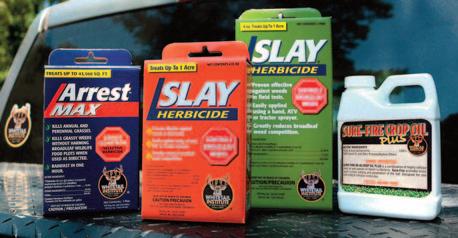
5 minute read
Arrest MAX and Slay: The Most Effective Selective Herbicides to Maintain Perennial Food Plots
Arrest MAX and SLAY

Advertisement


The Most Effective Selective Herbicides to Maintain Perennial Food Plots
f you want to maximize the performance and longevity of your perennial food plots you would be well advised to do a little maintenance each spring and summer after planting. One of the most important maintenance steps you can take is to control grasses and broadleaf weeds. While mowing is an important part of weed control, don’t forget that the Whitetail Institute offers Arrest MAX™ and Slay™, two selective herbicides that are highly effective tools in your grass and weed control arsenal.
Why is it important to control grass and other weeds in perennial food plots? There are a number of reasons. Weeds and grasses generally tend to establish in areas that are bare or where a food plot 46 WHITETAIL NEWS / Vol. 29, No. 3
stand is thin. By keeping grass and other weeds under control, you free up root space for your perennials to take over. Grass and other weeds also utilize soil nutrients and moisture that otherwise would be available for use by your food plot plants. And the problem’s not limited to just competition for resources. It’s the fact that grasses and other weeds can win the competition and take over even the most robust food plot planting if left unchecked. This is especially true of grass. Controlling grass and other weeds in perennial food plots is usually easy. Make sure you do it in a timely manner each spring to help ensure that your perennials stay lush, thick, nutritious, attractive and last for as many years as possible.
Arrest MAX and Slay — Generally. Arrest MAX and Slay are selective herbicides specifically designed by the Whitetail Institute for controlling grass and other weeds in food plots. Arrest MAX is designed to control most kinds of grassy weeds, and it can be used in any Whitetail Institute perennial forage stand, and in many other nongrassy crops (Arrest Max can also be used on PowerPlant). Slay is designed to control a few types of grassy weeds and most kinds of broadleaf weeds, and it is labeled for use in Imperial Whitetail Clover and in any other clover or alfalfa stand. Like Arrest MAX, Slay can also be used in other types of forage stands, but not all, so if you are planning to spray Arrest MAX and/or Slay in a forage stand other than the types specified above, check the herbicide label to make sure the forage is a listed crop, or call the Whitetail Institute for advice at (800) 688-3030 before you spray! Surefire Crop Oil PLUS. Surefire Crop Oil PLUS is an agricultural
oil of the type that the Slay label says must be added to the Slay spray tank in order for Slay to work. Surefire is also highly recommended for use with Arrest MAX to help it control grassy weeds that are perennial or mature.
Like Arrest MAX and Slay, Surefire Crop Oil PLUS is specifically designed for use in food plots. For instance, it is vegetable-based, not petroleum-based like some other agricultural oils. Surefire also contains an anti-foaming agent to help food plotters mix the spray tank correctly.
Timing the Arrest MAX Spray Application. Since Arrest MAX is a foliar-uptake herbicide, it should be sprayed only when grassy weeds are actively growing. And since Arrest MAX is a small-weed herbicide, it’s best to spray Arrest MAX before grasses reach 6-12 inches in height. Arrest MAX can still control or suppress most grassy weeds after they mature, but it may take multiple applications several weeks apart to do so. Arrest MAX can be sprayed even on newly planted labeled crops that are still very young without harming them. For best results, weeds to be treated with Slay should be sprayed while they’re still young, before they reach a height of about 6-12 inches. However, DO NOT SPRAY SLAY ON NEWLY PLANTED FOOD PLOTS UNTIL THEY ARE ESTABLISHED. Clover, for example, should not be sprayed with Slay until all the leaves are unfolded, which generally happens once the clover plants reach about 3 inches in height.
Arrest MAX and Slay can be tank-mixed together. You can find an easy-to-follow mix rate sheet at whitetailinstitute.com. To find it, go to either the Arrest MAX or Slay webpage, and click on “Recommended Mix Rates” link near the middle of the page. Cleaning the Sprayer After Use. Mix one quart of household ammonia per 25 gallons of water, and run it through the sprayer after use. This helps ensure optimum sprayer performance and minimizes the risk of herbicide contamination that might injure desirable plants on a subsequent spray trip. Put Safety First! All herbicide labels provide solid advice about the importance of wearing protective clothing when handling and applying herbicides. The most basic important items include chemicalresistant gloves, eye protection, long-sleeve shirt, long pants, and boots. Even though Arrest MAX and Slay are among some of the least toxic herbicides, be sure to follow the label’s advice about protective gear – they’re on the label for a reason.
That’s why the Whitetail Institute’s Weed and Herbicide Scientist, Dr. Carroll Johnson, takes along what he calls his “possibles bag” any time he sprays herbicides. His kit includes several gallons of potable water for clean-up, and emergency bathing in the event of a spill or exposure due to a ruptured spray line, as well as soap, household ammonia, an eye-flushing kit, and extra personal protective clothing. Final Thoughts. Hopefully, this article has helped clear up any confusion you may have had about herbicide use in maintaining Whitetail Institute perennial forage stands and helped explain the benefits of having better weed and grass-free plots that can last several years longer. Again, the herbicide label is the only official source of information about Arrest MAX, Slay or any other herbicide. The Arrest MAX and Slay labels and a FAQ are available at whitetailinstitute.com. And remember, if you still have questions after reading the Arrest MAX or Slay label, call the Whitetail Institute for advice before you spray! The Whitetail Institute’s in-house consultants are available to assist you at (800) 688-3030, 8:00am to 5:00pm Central Time, Monday through Friday. ^










